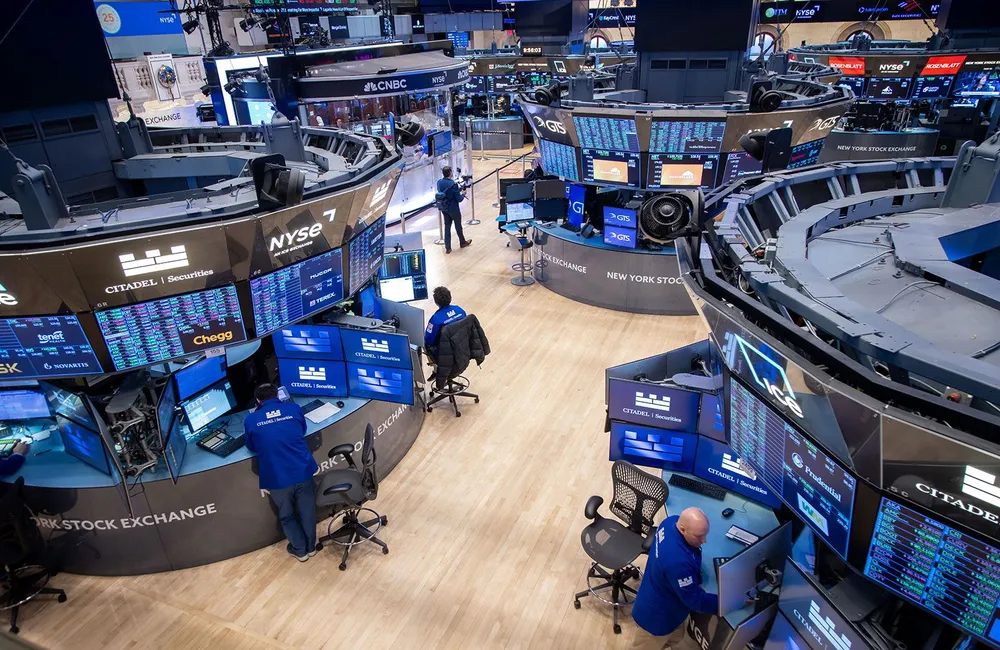In a great upwell of independent and minor party candidates, Labor will form government after defeating the Coalition on Saturday.
ASX futures were down 15 points or 0.2 percent at 7129 according to last trade on Saturday, suggesting modest decline at the open.
U.S. stocks open higher, then reversed direction, dropping for much of a wildly choppy session. At one point, the S&P 500 fell so much that it was set to end at least 20 percent lower from its January high in what would have been considered a bear market. A rally in the last hour of the trading day sent the index higher, and the S&P 500 closed up 0.57 point, or less than 0.1 percent; at its intraday low, it was down 2.3 percent.
The Dow Jones industrial average rose 8.77 points, also less than 0.1%. The tech-heavy Nasdaq Composite dipped 0.3%. The Dow industrials recorded their eighth consecutive weekly loss, the longest stretch of such losses for the index since 1932, when the country was near the depths of the Great Depression.
Investors say the selloff is being driven by mounting worries about the state of the US and global economy. Over the first few months of the year, money managers fretted about whether the Federal Reserve’s interest-rate increases would hit hard the expensive stocks that had powered the market’s rise in recent years. This week, the pain spilled far beyond technology, unsettling many investors. The profits of major retailers were reported to be hurt by supply-chain disruptions and rising costs, triggering a selloff that resulted in the deepest one-day decline for both Target and Walmart since the crash of Black Monday in 1987.
“It becomes clear that we went from a pandemic into an inflation scare, and now we’re in a place where we have serious concerns about growth” in a matter of months, said Brian Levitt, a global market strategist at Invesco.
At home, the S&P/ASX 200 added 1.15 percent, closing at 7145.6 on Friday, to dodge its longest losing streak since 2016. Mining stocks helped the benchmark index shake off a negative lead from the US, where the S&P 500 and DJIA both closed at their lowest levels since March 2021.
Rio Tinto, BHP and Fortescue gained between 1.5% and 3.9%, as iron ore prices gained, while gold and lithium miners jumped even higher.
The heavyweight financial sector climbed 0.7% as strength for banks offset weakness for insurers.
Technology stocks continued their recent rally, with WiseTech, Xero and Block adding 2.8%, 3.4% and 9.9%, respectively.
Crown Resorts was up as much as 0.2% at A$12.84 after shareholders of the casino operator approved the takeover by the US private equity group for A$13.10 a share by a majority of more than 99%.
The energy sector had slipped after Woodside shareholders on Thursday voted through his $41 billion merger with BHP's petroleum business, which will hand BHP shareholders 914 million new Woodside shares.
The Aussie last bought 70.38 US cents, compared to 70.48 US cents previously. The Wall Street Journal Dollar Index, which measures the US dollar against 16 other currencies edged up to 95.42.
Asia
China stocks finished the session higher and in line with regional markets of Asian equities as traders digested the PBOC’s cut of an influential interest rate. There was also an emphasis on the dollar, which appeared to be declining from its recent strength following the most recent US corporate earnings which have dented hopes for the nation's economic growth. The benchmark Shanghai Composite Index climbed 1.6% to close at 3146.57, and its counterpart Shenzhen Composite Index also gained 1.6% to end at 1983.67. The ChiNext Price Index, which tracks technology stocks, stood out with a 1.7% gain to 2417.35. Coal miners and companies along the coal supply chain made gains, with production activities in China increasingly kicking into gear and lifting power and electricity demand throughout the nation.
Hong Kong’s Hang Seng Index finished up 3.0% at 20717.24, following rises in US stock futures. Asian technology stocks powered higher after their US ADRs rose on Thursday, KGI Securities analyst Chua Tit Hong wrote in a note. The Hang Seng Tech index jumped 4.7% to 4284.42. Among technology stocks, JD. com advanced 5.9% and Alibaba Group gained 5.6%. Other gainers included Wuxi Biologics (Cayman), which climbed 7.9 percent, and China Merchants Bank, which added 7.3 percent. Among decliners was Country Garden Services Holdings, which lost 0.8%.
Japanese shares rose, led by electronics, tech stocks, as the market offset Thursday's selloff. Hoya Corp. rises 5.3% and SoftBank Group advances 3.5%. Shares of Seiko Epson soar 8.8%, after the company announced a share buyback program and a special dividend. The Nikkei Stock Average adds 1.3% to 26739.03, after siding 1.9% lower on Thursday. Investors are tracking the movements of crude-oil prices and news on Covid-19 lockdowns in China.
Europe
European markets wrapped up the day higher on the back of an upbeat session in Asia, although Wall Street finds itself on the back foot. The pan-European Stoxx Europe 600 rose 0.7 percent, while the German DAX added 0.7 percent and the French CAC 40 touched up 0.2 percent.
“China’s overnight rate cut lifted sentiment but investors are still nervous of going back into stocks after this week’s tumult,” IG analyst Chris Beauchamp writes in a note. “The jump in German factory-gate prices and decline in UK consumer confidence show that the wider backdrop remains quite negative for equities.”
London’s FTSE 100 gained 1.17% Friday as Chinese rate cut overnight lifted sentiment between European indices but investors still appear jittery.
“It’s been yet another see-saw week in markets, with a rally in the first part of the week turned to dust in the second, but China’s rate cut has given the cover for a bounce in global stocks in order to finish off the week,” Beauchamp writes in a research note. This may well be a short covering rally and sell to get out at a better price, he says. “Next week’s Fed minutes will remind markets that there’s more to come from Powell et al, even if the BoE has a trickier balancing act.”
North America
A weeklong stock selloff gained new force Friday, coming within a hair of ending the bull market that began with the start of the coronavirus pandemic.
Stocks climbed at the open, then turned around, declining during much of the volatile day. At one point the S&P 500 had fallen so far that it was headed for a close at least 20 percent below its January peak which would count as a bear market. A rally in the last hour of the trading day drove the index higher, and the S&P 500 finished up 0.57 point, or less than 0.1 percent; at its session low, it was down 2.3 percent.
The Dow Jones Industrial Average closed up 8.77 points, also less than 0.1%. The tech-heavy Nasdaq composite slid 0.3%.
Stocks haven’t dropped for that long in decades. The Dow industrials recorded their eighth consecutive weekly loss near their longest such losing streak in 1932, around the peak of the Great Depression. The S&P 500 and Nasdaq, meanwhile, fell for a seventh straight week, the longest such stretch since after the dot-com bubble’s burst in 2001. All three indexes ended the week down at least 2.9%.
The main culprit behind the selloff, investors say, is increasing concern over the health of the US and global economy. Money managers spent the earliest months of the year fretting that the interest-rate increases by the Federal Reserve would wreak havoc on the pricey stocks that powered the market’s advance in recent years. Investors fled shares of technology companies, yanking billions of dollars out of funds that track the Nasdaq. Higher interest rates tend to dim the appeal of companies that are hoping to deliver big profits years into the future.
This week, the pain extended well beyond the technology sector, raising alarms for many investors. Other major retailers reported their profits squeezed by rising costs and supply-chain disruptions, a selloff that produced Target and Walmart’s worst one-day drop since the Black Monday crash of 1987. As investors processed how inflationary pressures and slowing growth might weigh on corporate profits in the months ahead, shares of everything from banks to real-estate investment trusts to grocery store chains fell, as well.
The ferocity of the selling delivered a stark message to investors and analysts: There are few if any safe havens in the stock market this year. On Friday, even shares of energy companies that have written soaring oil prices fell alongside the broader market.
“It’s clear that in the span of just a few months we went from pandemic to inflation scare to now serious concerns around growth,” said Brian Levitt, global market strategist at Invesco.
Goldman Sachs economists put the odds at 35% that the US economy will slip into recession at some point over the next two years. Economic slowdowns have long been bad news for stocks: Since World War II, the S&P 500 has dropped an average of 30 percent from peak to trough in recessions.
Analysts said it was unlikely that markets would stabilize until the Fed proves to investors that it is capable of tightening monetary policy and bringing inflation under control without crashing the economy. There will be things outside the central bank’s control that will complicate its task, given that inflationary pressures have been compounded this year by China’s zero-Covid policy and Russia’s invasion of Ukraine.
“There is still more evidence that needs to be constructed to persuade markets that a soft landing is feasible,” said Arun Sai, a multi-asset strategist at Pictet Asset Management.
Treasury bonds rallied Friday, a buoy benefiting from investors rushing toward assets that historically do well in periods of economic strain. The yield on the 10-year US Treasury note, a benchmark for many interest rates, dropped Friday to 2.785% from 2.854% on Thursday. When yields go down, bond prices go up.
At the same time, poor earnings results fueled outsized moves in certain stocks.
Ross Stores shares fell $20.83, or 22 percent, to $71.87 after it reported a drop in sales and said it expects to see another decline in sales in the current quarter. The retailer, which serves as a barometer for other businesses, said its results had been hurt by rising costs for transportation and labor.
Agricultural equipment maker Deere fell $51.31, or 14%, to $313.31 even after reporting higher sales and profit and raising its profit forecast for the year. The company said supply-chain problems interrupted production levels and deliveries and that rising costs of materials and freight transportation are squeezing its profit margins. Many S&P 500 companies have so far delivered a quarter of earnings that have exceeded expectations, Kiran Ganesh, a multi-asset strategist at UBS, said.
What’s less clear is how companies will perform in the months ahead.
“It’s the question from a couple of quarters out that we’re going to see the full effect of the spike in oil prices and the war in Ukraine,” Mr. Ganesh said.





















